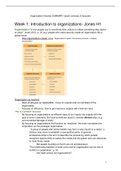Organization theories SUMMARY (book summary & lectures)
Week 1: Introduction to organizations- Jones H1
Organization= “A tool people use to coordinate their actions to obtain something they desire
or value”, Jones 2013, p. 24 (e.g. people who value security create an organization like a
police force)
- How organizations create value: Organization’s input> Conversion process > Output>
environment
-
Organization as machine
- Sees employees as replaceable - focus on outputs and not members of the
organization.
- Focuses on efficiency: how to get maximum outputs with minimum input
This is a problem because
- By focusing on organizations as efficient ways to turn inputs into outputs with the
goal to serve customers, the book sometimes doesn’t consider ethical sides (e.g.
environmental damage of shell)
- By focusing on organizations that function as ‘machines’ the book normalizes the
corporation as the prototype organization.
- ´ A group of people with similar beliefs may form a new church or a nation ´s
citizens may move to establish a new political party. In general,
entrepreneurship is the term to describe the process by which people
recognize opportunities to satisfy the needs and the gather and use resources
to meet those needs.
- But people founding a church are not entrepreneurs
- ”The relationship between a trade union and an organization can be one of
conflict or cooperation.” p. 55
- Are trade unions not organizations?
1
,Why do we use this book?
- Organizational efficiency is important for all types of organizations.
- Many of the theories are applicable for many types of organizations.
- It is good to get used to the lingo that the book uses because it is likely that some of
it is relevant in your working life.
5 reasons Why organizations exist:
1.To increase specialization and the division of
labor: People who work in organizations may
become more productive and efficient at what
they do than people who work alone > Save
cost
2. To use large-scale technology: Advantage
of economies of scales and scope.
3. To manage the organizational environment:
Individuals don’t have the same resources as
an organization (e.g. organization stand
political stronger than an individual)
4. economize on transaction cost= The costs
associated with negotiating, monitoring, and
governing exchanges between people.
5. To exert power and control: How organizations can make individual workers comply with
certain tasks to increase efficiency.
Economies of scope: If you make a wide enough variety of products, you can utilize
resources, such as the cheese, more effectively, because you can share them on different
products. e.g. different kind of cars
Organizational structure = the formal system of task and authority relationships that
controls how people are cooperate and use resources to achieve the organization’s goals
- Controls coordination and motivation; shapes behavior of people and the
organization.
- Is a response to contingencies (onvoorziene omstandigheden) involving
environment, technology, and human
resources
- Evolves as organization grows and differentiates
- Can be managed and changed through the process of organizational design
2
,How do managers measure organizational effectiveness?
- Control : this means having control over the external environment and having
the ability to attract resources and customers.
- Innovation: this means developing an organization’s skills and capabilities so
the organization can discover new products and processes.
- Efficiency: this means developing modern production facilities using new
information technologies that can produce/ distribute in the most efficient way
Ways to measure organizational effectiveness: external resource approach (control environment),
internal system approach (effectiveness within organization), technical approach (productivity and efficiency
output) (see table 1.1.)
Organizational Change = the process by which organizations redesign their structures
and cultures to move from their present state to some desired future state to increase
their effectiveness → the goal is to find new or improved ways of using resources and
capabilities to increase an organization’s ability to create value, and hence its
performance
Two kinds of goals managers use to assess how well the organization is performing:
- Official goals: guiding principles that the organization formally states in its annual
report and in other public documents. These goals usually lay out the mission of the
organization
- Operative goals: specific long- and short-term goals that guide managers and
employees as the perform the work of the organization
3
, Week 2; Stakeholders, Managers and Ethics
Jones H2+ Wright &Nyberg article
Statements
- All companies have shares, not all organizations
- Not all companies have a board of directors (think about family business)
Top- management hierarchy
Ownership
shareholders; have the ultimate authority over the use of
an organization’s resources
Trusteeship
* Board of director; Representatives of the shareholders,
they monitor the corporate management activities and
rewards , hire and fire them. (they make important
decision)
- Inside directors: Hold offices in a company’s formal
hierarchy, part of corporate management team e.g. CEO
is sometimes part of the board of directors
- Outside directors: Not full -time employees, represents
often major chairholders
*Executive committee: Most important directors
*Salary committee: determines salary/ bonus of the top
level
Corporate management/ board of management
Has the ultimate responsibility for setting company goals and
objectives, for allocating organizational resources to achieve
objectives, and for designing the organization’s structure
- CEO; the person ultimately responsible for setting
organizational strategy and policy. So, the CEO has the
most power, even though the board is ‘above’ the CEO
- COO; Responsible for the organization's internal operation
- Executive vice president; for overseeing and managing a
company’s most significant line and staff responsibilities
- Top management team; a group of managers who report to
the CEO and COO
- Divisional; managers who set policy only for the division they
head
- functional management managers who are responsible
for developing the functional skills and capabilities that collectively provide the core
competences that give the organization its competitive advantage
4






